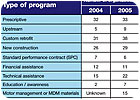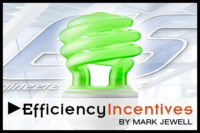
TABLE 1. Breakdown of program types. Most organizations surveyed offer more than one type of program. (Table excerpted from the “2007 CEE Summary of Energy-Efficiency Incentive Programs for Motors & Drives.”)
In retrofits or new construction, rebates can make a smart motor decision even smarter.
It may seem counterintuitive that an electric utility would pay its customers to use less of the only commodity it sells. However, many factors are causing both electric and gas utilities (as well as governments and other agencies) to support programs that help customers do just that.
The need to alleviate existing transmission and distribution bottlenecks, regulations limiting the construction of new generating capacity, and the growing urgency to reduce the combustion of fossil fuels and associated greenhouse gases have made conservation a vital part of satisfying any new energy demand.
Rebates and other incentives to encourage energy efficiency (hereinafter, “rebates”) have been around for more than three decades, starting with the first oil shock in the mid-seventies. Since then, rebate funding levels have varied from year to year, increasing as ratepayers and regulators reacted to rising energy prices, and decreasing as utility deregulation in the mid-nineties caused attention to shift from the demand side to the supply side. Today, funding levels are once again on the rise as the utility sector redoubles its efforts to address both grid reliability and global warming concerns.
This upward trend in funding will likely continue for the foreseeable future. Legislatures across the country continue to set aggressive goals for reducing greenhouse gas emissions. States with a history of offering robust rebates could reach even higher funding levels as they struggle to meet those goals. Moreover, similar pressures are causing many states that never had significant rebate programs to create them.
Rebate Economics
Rebates are typically paid to encourage installations that are more energy-efficient than what is required by code. Some rebates broaden the appeal of new commercially available but expensive technologies. Others make incremental improvements in efficiency more affordable. Rebates can help pay for energy-related products (e.g., lighting, motors, drives), services (e.g., commissioning), or a combination of the two. In most cases, a rebate lowers the project’s first cost, shortening the simple payback period and making that project easier to approve.The goal of this new column inEngineered Systemsis to keep readers informed about rebate-related issues and trends. Each quarter we will examine at least one energy-related technology and provide insight into applicable funding sources. In this first installment, we address motors, an important, yet often overlooked, category of energy-consuming equipment.
Motoring Your Way To Savings
A motor’s first cost is typically dwarfed by the value of the energy required to run it over its lifetime. That’s why it makes sense to select the most efficient motor available unless the motor will be operating less than 2,000 hrs/yr. In cases where a motor operates continuously and/or utility rates are high, the savings can really add up over time.Motor-related rebate programs vary widely. Assistance can take the form of financial incentives that help offset the incremental cost of higher efficiency, or technical support to aid decision-making. Some programs simply offer education and outreach activities that highlight the potential for significant savings.
A recent survey conducted by the Consortium for Energy Efficiency (CEE), provides insight into the variability and popularity of various motor program designs (Table 1). Of the 77 member organizations contacted by CEE, 48 indicated that they administer programs offering financial, technical, and/or educational support for premium efficiency motors, motor management, motor system optimization, or adjustable speed drives (ASDs). Several respondents (e.g., Bonneville Power Administration) work with their own utility members to administer common programs within a region.
Show Me The Motor Money!
Programs that offer financial assistance vary in how they determine incentive eligibility. Some of the CEE respondents cited above require that motors meet NEMA PremiumTM efficiency levels. Others offer prescriptive incentive payments for motors that meet CEE-developed specifications and consider motors outside this range on a custom basis. Some specify minimum kWh savings requirements. And some base their incentive payments on the magnitude of the reduction in energy usage compared to a certain baseline.Motor efficiency programs can be regional, statewide, or service-territory-specific. Sometimes a program moves from one category to another as it evolves. For example, the MotorUp program began as a regional initiative across New England but is now administered on a more local basis by a program manager at each participating utility.
As of the end of 2006, the MotorUp program had processed over 8,850 rebate applications involving 11,900 motors that together comprised 240,000 connected horsepower. Those applications are now allowing various businesses across New England to save about 2,488 kW and 12.7 million kWh/yr. That equates to roughly $1.3 million in energy savings annually - a figure that will escalate as electricity costs continue to rise. For more information on utility programs associated with MotorUp, visitwww.motoruponline.com. And to learn more about motor programs offered by CEE members, visitwww.motorsmatter.org/tools/programs2007.pdf.
Driving Faster Paybacks
A motor that runs continuously can have high annual energy costs even when electricity rates are low. However, increased energy efficiency may not be enough to justify motor replacement on its own.If a motor’s load were highly variable, installing an ASD could be a cost-effective path to capturing significant savings. Remember that while the volume of air or water decreases directly with reductions in fan or pump speed, the power consumption of the motor turning that fan or pump decreases with the cube of speed. So, even small reductions in speed can yield significant reductions in power consumption.
Today, many utility programs offer ASD incentives for a wide variety of motor applications and customer segments. Most motor programs limit incentive eligibility based on factors such as horsepower, minimum operating hours, and/or minimum estimated energy savings per year. Some ASD programs go a step further by requiring that any existing throttling device (e.g., inlet vanes) be removed or permanently disabled before the ASD incentive is approved for payment.ES




